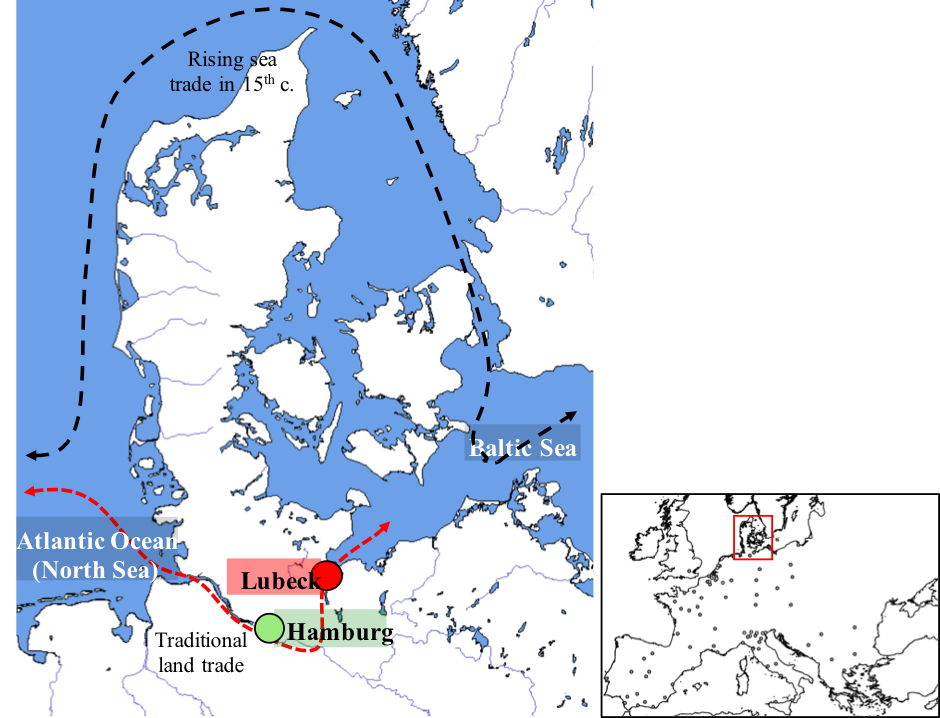From ProMarket,:
The German cities of Hamburg and Lübeck have an interwoven and eventful history. Whereas Lübeck offers an example of how dominant cities may become unattractive and decline when they end up serving the interests of a privileged few and refuse to change, Hamburg serves as a tale of how cities can reinvent themselves by changing with the times.
The cities of Hamburg and Lübeck in the north of Germany are just 65 kilometers (40 miles) apart. Yet, given the shape of the Jutland peninsula, Hamburg lies on the Atlantic coast, while Lübeck lies on the Baltic.The two cities have an interwoven and eventful history. Both Hamburg and Lübeck were members of the medieval Hanseatic League. This league was a federation of merchant guilds—an association of wholesale traders that had a privileged regional monopoly over trade—that traded across northern Europe. These guilds were the dominant way of doing trade across medieval Europe.Within the Hanseatic League, Hamburg and Lübeck were sprawling cities. While Lübeck served as the chief Baltic entrepôt of Europe, Hamburg provided the Hanseatic League with access to the Atlantic. Between the two cities lay the elaborate Elbe river and canal system to facilitate transport of goods. Lübeck prided itself on being the Queen of the Hanseatic until the fifteenth century, while Hamburg was its smaller, allied partner.

Nov. 13Times became rocky for the Hanseatic system in the fifteenth century. This was in part due to the rise of the Dutch, who were once beneficiaries of trade with the Hanseatic but were now the league’s seafaring competitors. Before the arrival of the Dutch, almost all trade to and from the Baltic passed through Lübeck. Likewise, Hamburg benefited from being the sole major Atlantic port of the Hanseatic. The link between Lübeck and Hamburg was a crucial route for trade in the north. However, the Dutch began to trade with the Baltic by navigating around the Jutland peninsula and through the Sound (Øresund). Thus, the Dutch soon began to reach the Baltic shores without the need to visit Hamburg and/or Lübeck. This competition from the Dutch disrupted the two cities’ centuries-old domination over trade between the Atlantic and the Baltic.How did the two cities respond? Differently. Lübeck responded to this competition with the Dutch by giving more privileges to its own merchants and by leading a persistent attempt to disrupt the Dutch trade through the Sound (which included taking part in the Dano Hanseatic War of 1426-35 and the Dutch Hanseatic War of 1438-41). In contrast, while Hamburg initially was an ally to Lübeck in its resistance to the Dutch (including in the two wars), it eventually began to diverge from its partner in the sixteenth century. Hamburg opened trade to all locals and non-locals, and instead of resisting this rising Dutch trade, it “adapted itself perfectly to the changing situation” and moved toward an open system of trade that welcomed diverse merchants (Dollinger, 1970, p. 355). Thus, Hamburg internally reformed, and the centuries-old privileges that a few of its merchants enjoyed declined, especially in the sixteenth century. This made a difference.Hamburg over time became integrated with the Atlantic trading system to its west, and expanded as a major Atlantic entrepôt of northern Europe. Traders from around Europe could trade in Hamburg, and this attracted more merchants and more trade. And what about Lübeck? While the traditional traders held onto their privileges in the city, Lübeck as a whole declined slowly but persistently, especially after the sixteenth century.Dollinger (1970, p. 372), recounting the decline of Lübeck in his classic book The German Hansa, wrote:...MUCH MORE